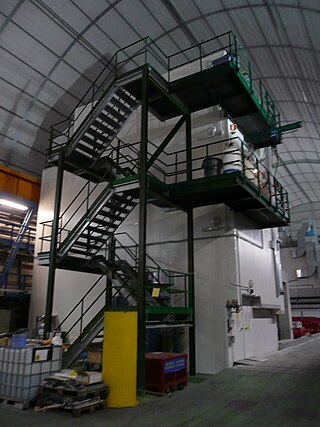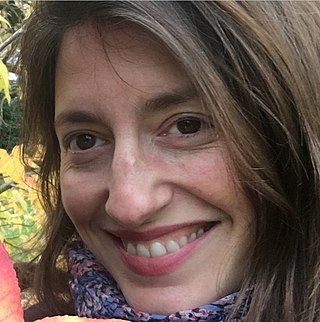Related Research Articles
Weakly interacting massive particles (WIMPs) are hypothetical particles that are one of the proposed candidates for dark matter.
The XENON dark matter research project, operated at the Italian Gran Sasso National Laboratory, is a deep underground detector facility featuring increasingly ambitious experiments aiming to detect hypothetical dark matter particles. The experiments aim to detect particles in the form of weakly interacting massive particles (WIMPs) by looking for rare nuclear recoil interactions in a liquid xenon target chamber. The current detector consists of a dual phase time projection chamber (TPC).

SNOLAB is a Canadian underground science laboratory specializing in neutrino and dark matter physics. Located 2 km below the surface in Vale's Creighton nickel mine near Sudbury, Ontario, SNOLAB is an expansion of the existing facilities constructed for the original Sudbury Neutrino Observatory (SNO) solar neutrino experiment.
The ArDM Experiment was a particle physics experiment based on a liquid argon detector, aiming at measuring signals from WIMPs, which may constitute the Dark Matter in the universe. Elastic scattering of WIMPs from argon nuclei is measurable by observing free electrons from ionization and photons from scintillation, which are produced by the recoiling nucleus interacting with neighbouring atoms. The ionization and scintillation signals can be measured with dedicated readout techniques, which constituted a fundamental part of the detector.

DEAP is a direct dark matter search experiment which uses liquid argon as a target material. DEAP utilizes background discrimination based on the characteristic scintillation pulse-shape of argon. A first-generation detector (DEAP-1) with a 7 kg target mass was operated at Queen's University to test the performance of pulse-shape discrimination at low recoil energies in liquid argon. DEAP-1 was then moved to SNOLAB, 2 km below Earth's surface, in October 2007 and collected data into 2011.

The Large Underground Xenon experiment (LUX) aimed to directly detect weakly interacting massive particle (WIMP) dark matter interactions with ordinary matter on Earth. Despite the wealth of (gravitational) evidence supporting the existence of non-baryonic dark matter in the Universe, dark matter particles in our galaxy have never been directly detected in an experiment. LUX utilized a 370 kg liquid xenon detection mass in a time-projection chamber (TPC) to identify individual particle interactions, searching for faint dark matter interactions with unprecedented sensitivity.

The Cryogenic Rare Event Search with Superconducting Thermometers (CRESST) is a collaboration of European experimental particle physics groups involved in the construction of cryogenic detectors for direct dark matter searches. The participating institutes are the Max Planck Institute for Physics (Munich), Technical University of Munich, University of Tübingen (Germany), University of Oxford, the Comenius University Bratislava (Slovakia) and the Istituto Nazionale di Fisica Nucleare.
Light dark matter, in astronomy and cosmology, are dark matter weakly interacting massive particles (WIMPS) candidates with masses less than 1 GeV. These particles are heavier than warm dark matter and hot dark matter, but are lighter than the traditional forms of cold dark matter, such as Massive Compact Halo Objects (MACHOs). The Lee-Weinberg bound limits the mass of the favored dark matter candidate, WIMPs, that interact via the weak interaction to GeV. This bound arises as follows. The lower the mass of WIMPs is, the lower the annihilation cross section, which is of the order , where m is the WIMP mass and M the mass of the Z-boson. This means that low mass WIMPs, which would be abundantly produced in the early universe, freeze out much earlier and thus at a higher temperature, than higher mass WIMPs. This leads to a higher relic WIMP density. If the mass is lower than GeV the WIMP relic density would overclose the universe.
The DAMA/LIBRA experiment is a particle detector experiment designed to detect dark matter using the direct detection approach, by using a matrix of NaI(Tl) scintillation detectors to detect dark matter particles in the galactic halo. The experiment aims to find an annual modulation of the number of detection events, caused by the variation of the velocity of the detector relative to the dark matter halo as the Earth orbits the Sun. It is located underground at the Laboratori Nazionali del Gran Sasso in Italy.

The European Underground Rare Event Calorimeter Array (EURECA) is a planned dark matter search experiment using cryogenic detectors and an absorber mass of up to 1 tonne. The project will be built in the Modane Underground Laboratory and will bring together researchers working on the CRESST and EDELWEISS experiments.

EDELWEISS is a dark matter search experiment located at the Modane Underground Laboratory in France. The experiment uses cryogenic detectors, measuring both the phonon and ionization signals produced by particle interactions in germanium crystals. This technique allows nuclear recoils events to be distinguished from electron recoil events.
SIMPLE is an experiment search for direct evidence of dark matter. It is located in a 61 m3 cavern at the 500 level of the Laboratoire Souterrain à Bas Bruit near Apt in southern France. The experiment is predominantly sensitive to spin-dependent interactions of weakly interacting massive particles.
The Korea Invisible Mass Search (KIMS), is a South Korean experiment, led by Sun Kee Kim, searching for weakly interacting massive particles (WIMPs), one of the candidates for dark matter. The experiments use CsI(Tl) crystals at Yangyang Underground Laboratory (Y2L), in tunnels from a preexisting underground power plant. KIMS is supported by the Creative Research Initiative program of the Korea Science and Engineering Foundation. It is the first physics experiment located, and largely built, in Korea.
The Particle and Astrophysical Xenon Detector, or PandaX, is a dark matter detection experiment at China Jinping Underground Laboratory (CJPL) in Sichuan, China. The experiment occupies the deepest underground laboratory in the world, and is among the largest of its kind.

The LUX-ZEPLIN (LZ) Experiment is a next-generation dark matter direct detection experiment hoping to observe weakly interacting massive particles (WIMP) scatters on nuclei. It was formed in 2012 by combining the LUX and ZEPLIN groups. It is currently a collaboration of 30 institutes in the US, UK, Portugal and South Korea. The experiment is located at the Sanford Underground Research Facility (SURF) in South Dakota, and is managed by the United States Department of Energy's (DOE) Lawrence Berkeley National Lab.
The CoGeNT experiment has searched for dark matter. It uses a single germanium crystal as a cryogenic detector for WIMP particles. CoGeNT has operated in the Soudan Underground Laboratory since 2009.

Jocelyn Monroe is an American British experimental particle physicist who is a professor at the University of Oxford. Her research considers the development of novel detectors as part of the search for dark matter. In 2016 she was honoured with the Breakthrough Prize in Fundamental Physics for her work on the Sudbury Neutrino Observatory.

ANAIS is a dark matter direct detection experiment located at the Canfranc Underground Laboratory (LSC), in Spain.
Direct detection of dark matter is the science of attempting to directly measure dark matter collisions in Earth-based experiments. Modern astrophysical measurements, such as from the Cosmic Microwave Background, strongly indicate that 85% of the matter content of the universe is unaccounted for. Although the existence of dark matter is widely believed, what form it takes or its precise properties has never been determined. There are three main avenues of research to detect dark matter: attempts to make dark matter in accelerators, indirect detection of dark matter annihilation, and direct detection of dark matter in terrestrial labs. The founding principle of direct dark matter detection is that since dark matter is known to exist in the local universe, as the Earth, Solar System, and the Milky Way Galaxy carve out a path through the universe they must intercept dark matter, regardless of what form it takes.
Daniel S. Akerib is an American particle physicist and astrophysicist. He was elected in 2008 a fellow of the American Physical Society (APS).
References
- 1 2 3 "WIMP Dark Matter" Archived 2002-06-01 at the Wayback Machine , CDMSII Overview, University of California, Berkeley
- ↑ B. Cabrera; L.M. Krauss; F. Wilczek (July 1985), "Bolometric detection of neutrinos", Phys. Rev. Lett., 55 (1): 25–28, Bibcode:1985PhRvL..55...25C, doi:10.1103/PhysRevLett.55.25, PMID 10031671
- ↑ M.W. Goodman; E. Witten (15 June 1985), "Detectability of certain dark matter candidates", Phys. Rev. D, 31 (12): 3059–3063, Bibcode:1985PhRvD..31.3059G, doi:10.1103/PhysRevD.31.3059, PMID 9955633
- ↑ Ananthaswamy, Anil (2010-03-02). The Edge of Physics: A Journey to Earth's Extremes to Unlock the Secrets of the Universe. HMH. ISBN 978-0-547-48846-2.
- ↑ "Latest Results in the Search for Dark Matter Thursday, December 17, 2009" Archived June 18, 2010, at the Wayback Machine
- ↑ "CDMS cryostat without detectors". Archived from the original on 2000-08-18. Retrieved 2011-09-23.
- ↑ CDMS Collaboration (21 Apr 2011). "Results from a Low-Energy Analysis of the CDMS II Germanium Data". Physical Review Letters. 106 (13): 131302. arXiv: 1011.2482 . Bibcode:2011PhRvL.106m1302A. doi:10.1103/PhysRevLett.106.131302. PMID 21517371. S2CID 9879642.
- ↑ CDMS Collaboration (4 May 2013). "Dark Matter Search Results Using the Silicon Detectors of CDMS II". Physical Review Letters. 111 (25): 251301. arXiv: 1304.4279 . Bibcode:2013PhRvL.111y1301A. doi:10.1103/PhysRevLett.111.251301. PMID 24483735. S2CID 3073653.
- ↑ Agnese, R.; Anderson, A. J.; Asai, M.; Balakishiyeva, D.; Basu Thakur, R.; Bauer, D. A.; Beaty, J.; Billard, J.; Borgland, A.; Bowles, M. A.; Brandt, D.; Brink, P. L.; Bunker, R.; Cabrera, B.; Caldwell, D. O.; Cerdeno, D. G.; Chagani, H.; Chen, Y.; Cherry, M.; Cooley, J.; Cornell, B.; Crewdson, C. H.; Cushman, P.; Daal, M.; Devaney, D.; Di Stefano, P. C. F.; Silva, E. Do Couto E.; Doughty, T.; Esteban, L.; et al. (June 20, 2014). "Search for Low-Mass WIMPs with SuperCDMS". Phys. Rev. Lett. 112 (24): 241302. arXiv: 1402.7137 . Bibcode:2014PhRvL.112x1302A. doi:10.1103/PhysRevLett.112.241302. hdl:1721.1/88645. PMID 24996080. S2CID 119066853.
- 1 2 3 4 Cushman, Priscilla (2012-07-22), "The Cryogenic Dark Matter Search: Status and Future Plans" (PDF), IDM Conference
- 1 2 Saab, Tarek (2012-08-01), "The SuperCDMS Dark Matter Search" (PDF), SLAC Summer Institute 2012, SLAC National Accelerator Laboratory, archived from the original (PDF) on 2015-09-24, retrieved 2012-11-28 (presentation)
- 1 2 Rau, Wolfgang (25 July 2017). SuperCDMS SNOLAB—Status and Plans. XV International Conference on Topics in Astroparticle and Underground Physics (TAUP 2017). Sudbury, Canada.
- 1 2 Brink, Paul (25 June 2015). SuperCDMS results and plans for SNOLAB. 11th Patras Workshop on Axions, WIMPs and WISPs. Zaragoza, Spain.
- 1 2 Agnese, R.; et al. (SuperCDMS Collaboration) (2017-04-07). "Projected sensitivity of the SuperCDMS SNOLAB experiment" (PDF). Physical Review D . 95 (8): 082002. arXiv: 1610.00006 . Bibcode:2017PhRvD..95h2002A. doi:10.1103/PhysRevD.95.082002. hdl:1721.1/109800. S2CID 32272925. Archived from the original (PDF) on 2017-10-22. Retrieved 2017-10-22.
- ↑ "Second generation dark matter experiment coming to SNOLAB" (Press release). SNOLAB. 2014-07-18. Archived from the original on 2019-03-30. Retrieved 2014-09-18.
- ↑ "Construction Begins on SuperCDMS Dark Matter Experiment".
- ↑ "CERN" (PDF).
- ↑ "Sanford Lab" (PDF).
- ↑ "Indico" (PDF).
- ↑ Golwala, Sunil (2011-08-15). GEODM Interest in the SNOLAB Cryopit (PDF). Archived from the original (PDF) on 2016-03-04. Retrieved 2015-12-07.
